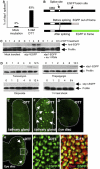Unfolded protein response in a Drosophila model for retinal degeneration
- PMID: 17170705
- PMCID: PMC1782370
- DOI: 10.1038/sj.emboj.7601477
Unfolded protein response in a Drosophila model for retinal degeneration
Abstract
Stress in the endoplasmic reticulum (ER stress) and its cellular response, the unfolded protein response (UPR), are implicated in a wide variety of diseases, but its significance in many disorders remains to be validated in vivo. Here, we analyzed a branch of the UPR mediated by xbp1 in Drosophila to establish its role in neurodegenerative diseases. The Drosophila xbp1 mRNA undergoes ire-1-mediated unconventional splicing in response to ER stress, and this property was used to develop a specific UPR marker, xbp1-EGFP, in which EGFP is expressed in frame only after ER stress. xbp1-EGFP responds specifically to ER stress, but not to proteins that form cytoplasmic aggregates. The ire-1/xbp1 pathway regulates heat shock cognate protein 3 (hsc3), an ER chaperone. xbp1 splicing and hsc3 induction occur in the retina of ninaE(G69D)-/+, a Drosophila model for autosomal dominant retinitis pigmentosa (ADRP), and reduction of xbp1 gene dosage accelerates retinal degeneration of these animals. These results demonstrate the role of the UPR in the Drosophila ADRP model and open new opportunities for examining the UPR in other Drosophila disease models.
Figures






Similar articles
-
Suppression of retinal degeneration in Drosophila by stimulation of ER-associated degradation.Proc Natl Acad Sci U S A. 2009 Oct 6;106(40):17043-8. doi: 10.1073/pnas.0905566106. Epub 2009 Sep 23. Proc Natl Acad Sci U S A. 2009. PMID: 19805114 Free PMC article.
-
Ire1 regulated XBP1 mRNA splicing is essential for the unfolded protein response (UPR) in Drosophila melanogaster.Biochem Biophys Res Commun. 2007 Mar 16;354(3):789-94. doi: 10.1016/j.bbrc.2007.01.056. Epub 2007 Jan 22. Biochem Biophys Res Commun. 2007. PMID: 17266933
-
Ire1 mediated mRNA splicing in a C-terminus deletion mutant of Drosophila Xbp1.PLoS One. 2014 Aug 19;9(8):e105588. doi: 10.1371/journal.pone.0105588. eCollection 2014. PLoS One. 2014. PMID: 25136861 Free PMC article.
-
Molecular genetics of retinal degeneration: A Drosophila perspective.Fly (Austin). 2011 Oct-Dec;5(4):356-68. doi: 10.4161/fly.5.4.17809. Epub 2011 Sep 7. Fly (Austin). 2011. PMID: 21897116 Free PMC article. Review.
-
Cellular stress signaling and the unfolded protein response in retinal degeneration: mechanisms and therapeutic implications.Mol Neurodegener. 2022 Mar 28;17(1):25. doi: 10.1186/s13024-022-00528-w. Mol Neurodegener. 2022. PMID: 35346303 Free PMC article. Review.
Cited by
-
PERK Limits Drosophila Lifespan by Promoting Intestinal Stem Cell Proliferation in Response to ER Stress.PLoS Genet. 2015 May 6;11(5):e1005220. doi: 10.1371/journal.pgen.1005220. eCollection 2015 May. PLoS Genet. 2015. PMID: 25945494 Free PMC article.
-
The effects of myocilin expression on functionally relevant trabecular meshwork genes: a mini-review.J Ocul Pharmacol Ther. 2014 Mar-Apr;30(2-3):202-12. doi: 10.1089/jop.2013.0218. Epub 2014 Feb 24. J Ocul Pharmacol Ther. 2014. PMID: 24564495 Free PMC article. Review.
-
The ER stress factor XBP1s prevents amyloid-beta neurotoxicity.Hum Mol Genet. 2011 Jun 1;20(11):2144-60. doi: 10.1093/hmg/ddr100. Epub 2011 Mar 9. Hum Mol Genet. 2011. PMID: 21389082 Free PMC article.
-
Review: retinal degeneration: focus on the unfolded protein response.Mol Vis. 2013 Sep 20;19:1985-98. eCollection 2013. Mol Vis. 2013. PMID: 24068865 Free PMC article. Review.
-
Conserved RNA structures in the non-canonical Hac1/Xbp1 intron.RNA Biol. 2011 Jul-Aug;8(4):552-6. doi: 10.4161/rna.8.4.15396. Epub 2011 Jul 1. RNA Biol. 2011. PMID: 21593604 Free PMC article.
References
-
- Armknecht S, Boutros M, Kiger A, Nybakken K, Mathey-Prevot B, Perrimon N (2005) High-throughput RNA interference screens in Drosophila tissue culture cells. Methods Enzymol 392: 55–73 - PubMed
-
- Back SH, Schroder M, Lee K, Zhang K, Kaufman RJ (2005) ER stress signaling by regulated splicing: IRE1/HAC1/XBP1. Methods 35: 395–416 - PubMed
-
- Bence NF, Sampat RM, Kopito RR (2001) Impairment of the ubiquitin–proteasome system by protein aggregation. Science 292: 1552–1555 - PubMed
-
- Brand AH, Perrimon N (1993) Targeted gene expression as a means of altering cell fates and generating dominant phenotypes. Development 118: 401–415 - PubMed
MeSH terms
Substances
LinkOut - more resources
Full Text Sources
Other Literature Sources
Molecular Biology Databases
Research Materials
Miscellaneous

